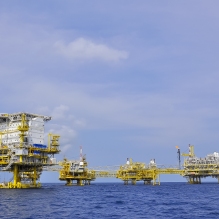Normally unattended installations
A Normally Unattended Installation (NUI) or sometimes also referred to as a Normally Unmanned Installations is an offshore facility primarily designed to be operated remotely through automated processes and without the presence of personnel. NUI is commonly utilised in shallower water where a building many small NUIs is an easier and cheaper option in comparison to the cost of using subsea wells. NUIs can also be used as a support platform to a nearby larger platform.

Normally unattended installations
This type of platform requires a unique maintenance strategy which effectiveness can be heavily influenced by several parameters such as travel times, maintenance resources constrains, mobilization time and prioritisation of repair. Therefore, integrating and measuring all these factors under a performance prediction study is of fundamental importance. By running a RAM analysis, the analyst will be able to check the effectiveness of a maintenance strategy and the criticality of the different systems comprising the platform.
As we discussed in our previous post, RAM analysis can be applied throughout the whole life-cycle of the project. The benefits of the analysis in the various life stages of a NUI include:
- Feasibility stage: to identify what is the most effective system configuration.
- Operation stage: to identify production efficiency of the NUI’s configuration; to plan for effective maintenance strategy.
- Decommissioning stage: to highlight the time where the operation is no longer justifiable (e.g. Operational Expenditure is higher than the Revenue) including NUI phasing out impact on production.
Prior to discussing the maintenance strategy, it is important to understand how these maintenance logistics challenges manifest themselves in the simulation. Consider a generic event in Maros, which begins with equipment run time followed by a failure. In real life, this failure introduces ‘repair delay’ time corresponding to the time required to diagnose the problem and organise the repair resources to carry out necessary repairs. Once all resources are on the job location, the actual repair procedure can then commence. The repair action itself may impact the production in another manner.
Modelling maintenance logistics involves determining the ‘repair delay’ portion of the above sequence. This is achieved by defining the location, quantity and constraints of the various resources involved in the repair process. Simulation is then carried out to determine each repair delay depending upon the foregoing and the workload at the instant of the failure. It is not simply a case of specifying a repair delay per task.
Therefore, when an equipment item/system fails, there are a number of important logistical and strategic issues involved in dealing with the ensuing repair task, typically:
- Where is the job to be performed (location)?
- What spare parts are required?
- What manpower requirements are required?
- What other support resources are required (lifting gear, scaffold etc.)?
- How important is the job (with respect to production downtime)?
- How are the resources going to get to the job location (transport, travel times)?
- Are there any opportunities to conduct other maintenance activities at this time (opportunity strategies, bringing forward PMRs etc.)?
All these questions can be answered with a RAM study and a more thorough analysis can be performed depending on the level of information required.
Author: Victor Borges
12/9/2014 10:20:31 PM
